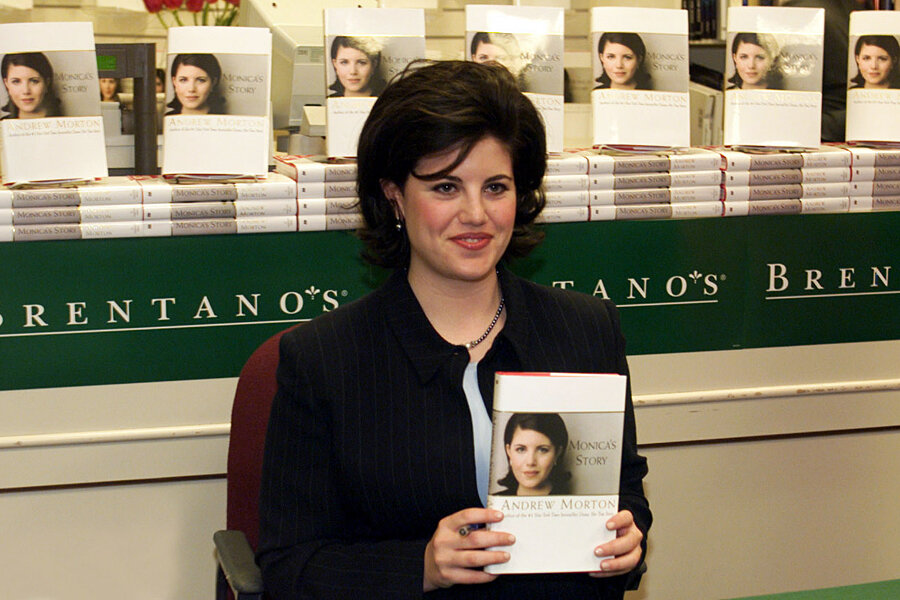Can Monica Lewinsky make a dent in cyberbullying?
Loading...
Yep, there it is: Monica Lewinsky's Twitter handle, @MonicaLewinsky. There's even the blue check mark symbol next to her name, verifying the account. Her first tweet? #HereWeGo.
The former White House intern whose affair with President Clinton resulted in his impeachment took her first steps into the Twittersphere Monday morning, shortly before speaking at a Philadelphia gathering of Millennials hosted by Forbes. And it's a Twitter presence that looks to be formidable. As of this writing, Ms. Lewinsky already has more than 23,000 followers.
More than a decade since the affair, the spotlight seems to follow her wherever she goes. This year, Lewinsky has taken moves to take ownership of her public image, beginning with a lengthy article in the May issue of Vanity Fair.
More than helping her own image, however, Lewinsky is using her unavoidable celebrity status to draw attention to the problem of Internet bullying. She cites herself as one of the first-ever examples of cyberbullying and says she wants to help others avoid the trauma she went through as a 24-year-old in 1998.
Speaking to an auditorium of Millennials at Forbes's inaugural 30 Under 30 summit, she called herself "Patient Zero," noting she was the first person "to have their reputation completely destroyed worldwide via the Internet."
"There was no Facebook, Twitter, or Instagram back then," she said, according to Forbes. "But there were gossip, news and entertainment websites replete with comment sections and e-mails which could be forwarded."
More than 15 years later, Lewinsky is still being mocked online. Several Twitter users have established spoof profiles making fun of her, which may explain how she managed to earn the coveted little blue checkmark verifying her account so quickly.
In her speech, she reportedly mentioned the 2010 suicide of Tyler Clementi, the Rutgers University freshman who took his own life by jumping off the George Washington Bridge after a roommate secretly filmed and streamed footage of Mr. Clementi kissing another man in their dorm room. Lewinsky, who met with Clementi's parents, told the crowd that as a survivor of online bullying and harassment she wants to prevent such tragedies from happening again.
But in the Internet age, cyberbullying can be difficult to prevent. As evidenced by the recent string of iCloud hacks that leaked hundreds of nude celebrity photos, online harassment can seemingly happen to anyone at any time.
According to a 2013 report from the United Kingdom-based antibullying charity Ditch the Label, 54 percent of "extreme cyberbullying" occurs on Facebook. More than half of all adolescents and teens have been victims of cyberbullying and roughly the same number have engaged in some form of online bullying, according to the website bullyingstatistics.org.
Facebook's community standards state that it "does not tolerate bullying or harassment" on its site. Still, while Facebook users can report material as spam, not all reported content will be removed as what's offensive to one person might not be offensive to someone else, the site notes, meaning potentially offensive or harmful material might not be removed even if reported. Similarly, Twitter offers steps for users to report unwanted behavior.
Both sites also urge users to "block" or "unfollow" users demonstrating unwelcome behavior. However, while those actions may briefly halt a user from receiving direct messages or notifications from an unwanted individual, they do not stop the ongoing bullying that can still occur on social media even when the targeted individual has taken steps to avoid seeing the behavior.
Different from more traditional forms of bullying – the kind kids might encounter in school yards – cyberbullying can happen 24 hours a day, seven days a week. Harassing messages can be disseminated anonymously and can zip around the web nearly instantaneously. What's more once a harassing message has been sent, it is often difficult to remove it from the web. According to the website stopbullying.gov, kids who are victims of cyberbullying are more likely to skip school, receive poorer grades, and experience health problems.








